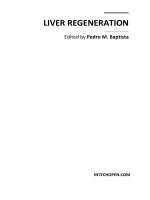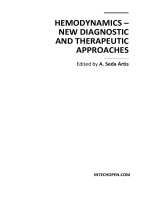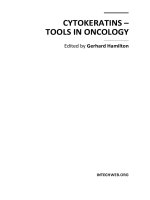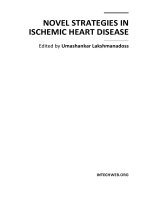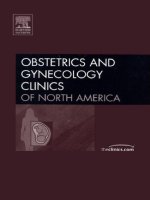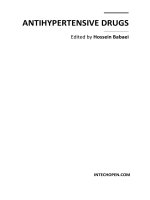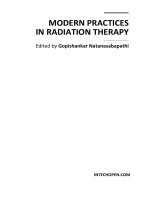Antihypertensive Drugs Edited by Hossein Babaei pdf
Bạn đang xem bản rút gọn của tài liệu. Xem và tải ngay bản đầy đủ của tài liệu tại đây (3.63 MB, 160 trang )
ANTIHYPERTENSIVE DRUGS
Edited by Hossein Babaei
Antihypertensive Drugs
Edited by Hossein Babaei
Published by InTech
Janeza Trdine 9, 51000 Rijeka, Croatia
Copyright © 2012 InTech
All chapters are Open Access distributed under the Creative Commons Attribution 3.0
license, which allows users to download, copy and build upon published articles even for
commercial purposes, as long as the author and publisher are properly credited, which
ensures maximum dissemination and a wider impact of our publications. After this work
has been published by InTech, authors have the right to republish it, in whole or part, in
any publication of which they are the author, and to make other personal use of the
work. Any republication, referencing or personal use of the work must explicitly identify
the original source.
As for readers, this license allows users to download, copy and build upon published
chapters even for commercial purposes, as long as the author and publisher are properly
credited, which ensures maximum dissemination and a wider impact of our publications.
Notice
Statements and opinions expressed in the chapters are these of the individual contributors
and not necessarily those of the editors or publisher. No responsibility is accepted for the
accuracy of information contained in the published chapters. The publisher assumes no
responsibility for any damage or injury to persons or property arising out of the use of any
materials, instructions, methods or ideas contained in the book.
Publishing Process Manager Sandra Bakic
Technical Editor Teodora Smiljanic
Cover Designer InTech Design Team
First published March, 2012
Printed in Croatia
A free online edition of this book is available at www.intechopen.com
Additional hard copies can be obtained from
Antihypertensive Drugs, Edited by Hossein Babaei
p. cm.
ISBN 978-953-51-0462-9
Contents
Preface VII
Chapter 1
New Therapeutics in Hypertension
Jorge Luis León Alvarez
1
Chapter 2
2+
Dual L/N-Type Ca Channel Blocker:
Cilnidipine as a New Type of Antihypertensive Drug 29
Akira Takahara
Chapter 3
Hypertension and Chronic Kidney Disease: Cause
and Consequence – Therapeutic Considerations 45
Elsa Morgado and Pedro Leão Neves
Chapter 4
Potassium-Sparing Diuretics in Hypertension 67
Cristiana Catena, GianLuca Colussi and Leonardo A. Sechi
Chapter 5
Hypertension and Renin-Angiotensin System
Roberto de Barros Silva
Chapter 6
Pharmacokinetic Interactions of
Antihypertensive Drugs with Citrus Juices 95
Yoshihiro Uesawa
Chapter 7
Drug Interaction Exposures in an Intensive
Care Unit: Population Under Antihypertensive Use 121
Érica Freire de Vasconcelos-Pereira,
Mônica Cristina Toffoli-Kadri,
Leandro dos Santos Maciel Cardinal
and Vanessa Terezinha Gubert de Matos
Chapter 8
The Use of Antihypertensive
Medicines in Primary Health Care Settings 131
Marc Twagirumukiza, Jan De Maeseneer, Thierry Christiaens,
Robert Vander Stichele and Luc Van Bortel
85
Preface
Hypertension or high blood pressure is widely prevalent and a major risk factor for
cardiovascular diseases including coronary heart disease, myocardial infarction and
stroke, and frequently causes damage to the arterial blood vessels, the eyes and
kidneys. Prolonged hypertension can also lead to enlargement of the heart and may
cause heart failure. This disease is usually asymptomatic until the damaging effects of
hypertension are observed. Therefore, hypertension is known as the "silent killer."
Several survey studies for assessing the burden of hypertension in different societies
revealed that many subjects with hypertension were unaware of their disease, many of
the aware subjects were not on treatment, and many of the treated patients were not
controlled properly, particularly in developing countries. Hypertension afflicts more
than one billion population worldwide and is a leading cause of morbidity and
mortality. It has been predicted that in year 2025 it will increase by 24% in developed
countries and 80% in developing countries. However, the expected increase may be
much higher than these projections.
This book is another contribution to the application of new knowledge in the area of
hypertension. Authors of this book are from different parts of the world sharing their
new knowledge and experience in the direction of deep understanding and more
clarification of the disease. They look from different angles to hypertension, providing
an invaluable resource not only for clinicians, but also for all medical sciences students
and health providers. I hope this book will provide new insight into hypertension
disease and greater visibility and access to detection and treatment of vulnerable
patients.
Prof. Hossein Babaei
Drug Applied Research Center,
School of Pharmacy,
Tabriz University of Medical Sciences,
Iran
1
New Therapeutics in Hypertension
Jorge Luis León Alvarez
Hospital Hermanos Ameijeiras,
Cuba
1. Introduction
Cardiovascular diseases are the leading cause of morbility and mortality worldwide. The
main risk factor that contributes to the development of these cardiovascular diseases is
hypertension. Hypertension increases the risk of injury in the vascular beds of various target
organs such as retina, brain, heart and kidneys. Morbility and mortality associated with
hypertension is associated mainly with cardiovascular complications. The main goal in the
treatment of hypertension is not only controlling blood pressure (BP), but also reducing
cardiovascular risk. (Chobanian et al., 2003)
The therapeutical management of hypertension has advanced considerably in recent
decades, both in terms of its efficacy in available treatments as in its safety and tolerability
profiles.(Table.1) Multiple effective antihypertensive drugs exist to carry out a logical choice.
It is necessary to take into account the pathogenic alterations of renin secretion, sympathetic
tone, renal sodium excretion, changes in cardiac output, peripheral vascular resistance and
blood volume, without forgetting the individual considerations in each patient. However,
none of the antihypertensive drugs currently available are able to control all cases of
hypertension by themselves. For this reason, monotherapy alone is not usually able to lower
BP to optimal levels in most patients. The use of combination therapy with antihypertensive
drugs has become the norm. (Calhoun et al., 2008). However, the number of people with
uncontrolled hypertension has increased, despite the innumerable evidence of the benefit of
BP control and the advances in therapy. (Kearney et al., 2005)
At present the new knowledge obtained about the renin angiotensin aldosterone system
(RAAS), the role of the endothelium and nitric oxide (NO), and the ion channels in the
homeostasis of BP among others, have opened new lines of study. Therapeutical
developments have recently emerged that could improve control of BP, either because they are
new and alternative therapeutic strategies, such as carotid sinus stimulation devices, renal
denervation and vaccination or due to the improved knowledge of existing alternatives.
This review will focus on little used antihypertensive drugs or on the emerging and
application of new therapeutic strategies such as vaccination, renal denervation and the
activation of baroreceptors.
2. Renin inhibitors
The importance of the RAAS in the pathogenesis of cardiovascular and renal diseases and
hypertension among them has encouraged research to achieve blocking it partially or
2
Antihypertensive Drugs
completely. The RAAS is composed of peptides and enzymes that lead to the synthesis of
angiotensin (Ang) II, which effects are mediated by the action of AT1 and AT2 receptors and
are involved in controlling cardiovascular function and hemodynamic equilibrium. (Morales
Olivas & Estañ Yago, 2010)
After more than a century of research on the RAAS, Ondetti and colleagues, discovered in
1977 captopril (first inhibitor of angiotensin converting enzyme or ACE inhibitors). (Ondetti,
Rubin & Cushman., 1977) In 1988, Timmermans and colleagues, (Timmermans et al., 1991)
developed losartan (first AT1 antagonist receptor or ARBs). Both ACE inhibitors and ARBs
have demonstrated their effectiveness in the control of hypertension delay, the natural
progression of heart failure (HF), diabetes mellitus, and reverse target organ damage such as
cardiac hypertrophy and thereby reduce cardiovascular and renal morbility and mortality.
(Chobanian et al., 2003) It is not until 2007 that the Food and Drug Administration (FDA)
approved the clinical use of aliskiren (first direct renin inhibitor taken orally). (Nussberger
et al., 2002) This new group of drugs may represent a superior therapeutical strategy than
that of other drugs that inhibit the RAAS, as they not only inhibit the actions mediated by
Ang II synthesis but also the direct actions of prorenin and renin through the stimulation of
prorenin receptors.
Decade
Antihypertensive drugs
1950
Reserpine, hydralazine, guanethidine, thiazide diuretics, ganglionic blockers
1960
Spironolactone, α 2 adrenergic receptor agonists, β blockers
1970
α 1 adrenergic receptor antagonists, ECA inhibitors, serotonin antagonists &
agonists
Calcium antagonists, imidazoline agonists, potassium channells openers
1980
1990
2000
2010
ARBs, antagonist of endothelin receptors, aminopeptidase A inhibitors, crosslink
breakers of the end products of advanced glycation, Rho kinase inhibitors
Ouabain antagonists, urotensin II antagonists, vascular NAD(P)H oxidase
inhibitors, modulators of the endocannabinoid, vasopeptidase inhibitors, renin
inhibitors, vaccines, renal sympathetic denervation, Rheos system
Dual inhibitors of neutral endopeptidase and angiotensin II blockers
Dual inhibitors of endothelin converting enzyme and neutral endopeptidase
NO releasing drugs with dual action: NO releasing sartans + NO releasing statins
Dual antagonist of angiotensin II and endothelin A receptors
Table 1. Hystoric evolution in antihypertensive therapeutics.
Aliskiren is a potent non peptide renin inhibitor. When there is binding of aliskiren to the
active site of renin (S1/S3), it blocks the activity of Asp32 and Asp215 of aspartate residue,
thus preventing the conversion of angiotensinogen to Ang I. Aliskiren is a hydrophilic
molecule with a high solubility in water, which facilitates their oral bioavailability. Aliskiren
is absorbed via the gut, it has a bioavailability of 2.5 to 3%, but its high affinity for renin
compensates the low bioavailability of the drug. Following oral administration, the peak
concentration is reached within 3 to 4 hours. Its half life is 36 hours reaching its stable level
in 7 days. Recent studies suggest that CYP3A4 is the enzyme responsible for aliskiren
metabolism. 90% of aliskiren is purified through the feces. (Wood et al., 2003) In controlled
clinical trials, aliskiren was shown to be as effective an antihypertensive drug as
New Therapeutics in Hypertension
3
monotherapy or ACE inhibitors and ARBs. (Weir et al., 2007) Aliskiren is effective and safe
in its combination with thiazide diuretics, ACE inhibitors, ARBs and blockers channels of
calcium (Sica et al., 2006, Drummond et al., 2007, Andersen et al., 2008, Parving et al., 2008)
With respect to the incidence of adverse events, serious and non serious, there are no
statistically significant differences between placebo and therapeutic doses of aliskiren, only
at doses of 600 mg of the drug showed an increase in the number of patients who had
diarrhea.
A comprehensive program of clinical trials: the ASPIRE HIGHER was assigned to evaluate
the influence of aliskiren on cardiovascular and renal protection beyond their
antihypertensive action. This big test covers four broad areas: the cardiorenal morbility and
mortality, the cardioprotective, the renoprotective and hypertension with approximately
35,000 patients in 14 studies. (ASPIRE HIGHER Clinical Trial Program) the final results of
three are already known.
In the study AVOID (Aliskiren in Evaluation of Proteinuria in Diabetes) aliskiren (150-300
mg/day) was administered to diabetic hypertensive patients with proteinuria. The study
found that in 6 months of treatment, the addition of aliskiren to conventional therapy in
patients with losartan 100 mg per day, conditioned a further reduction of 20% in the rate of
urinary albumin excretion, with a reduction greater than or equal to 50% in the urinary
excretion rate of albumin in 24.7% of patients receiving aliskiren compared with 12.5% of
patients receiving losartan alone. An important aspect that is worth noting is that the rate of
adverse effects did not increase in percentage or statistically with the addition of aliskiren to
losartan therapy. (Parving et al., 2008)
The ALOFT study (Aliskiren Observation Of Heart Failure Treatment) evaluated the effect
of adding aliskiren to the standard therapy for HF in a group of patients (including an ACE
inhibitor or an ARBs, but not both, as well as betablockers and diuretics if needed). The
addition of 150 mg of aliskiren conditioned significant reductions in natriuretic peptide
(NP), proBNP, and echocardiographic parameters related to diastolic function of patients
tested, compared with the group of patients who received conventional treatment.
(McMurray et al., 2008)
In the study ALLAY (Aliskiren in Left Ventricular Assessment of Hypertrophy) a group of
patients with hypertension, obesity and left ventricular hypertrophy were randomized to
receive: aliskiren (300 mg), losartan (100 mg), or the combination of aliskiren and losartan
with the doses mentioned. The primary endpoint was the evaluation of decreased left
ventricular mass after 34 weeks of treatment in the groups already defined. Aliskiren
provided a 15% decrease in left ventricular mass greater than the losartan, and the
association of aliskiren and losartan provided a drop of 36% higher than losartan alone. This
study confirmed the good tolerability of aliskiren and its combination with losartan.
(Solomon et al., 2008)
Although the rest of the clinical trials that make up the ASPIRE HIGHER are not avaible, the
use of aliskiren opens a new expectation, not only in the treatment and control of
hypertension, but also due to its effects on target organ damage and the reduction of
cardiovascular risk.
4
Antihypertensive Drugs
3. Imidazoline agonists
Many of the antihypertensive drugs that exert their action at the nervous system as
methyldopa, clonidine, guanfacine and guanabenz, act by stimulating alpha 2 central
receptors located in the pontomedular region and its effect consists in the reduction of the
sympathetic outflow with a decrease in the peripheral sympathetic activity, but
unfortunately they produce adverse reactions which include sedation, dry mouth and
impotence, which high occurrence has determined a progressive decrease in their use.
In 1984, articles on imidazoline receptors located in the central nervous system are
beginning to be published, and more recently, drugs capable of acting at this level leading to
a peripheral sympathetic inhibition. This mechanism of action similar to the classic agonists
differs mainly by a lower incidence of adverse reactions. (Yu & Frishman., 1996)
The existence of imidazoline receptors different from the alpha 2 was established in studies
in the brains of cattle which tested the affinity of clonidine with these sites. However,
because this drug shares its affinity for both imidazoline receptor as the alpha 2 receptor,
new compounds were developed with high selectivity for imidazoline receptors, among
which moxonidine and rilmenidine are of the most extensive development. Its action is
performed on type I receptors, which include those that exert regulatory actions on BP. (Van
Zwieten., 1996) There are also type II imidazoline receptors which are related to the
stimulation of insulin release and some metabolic processes in the brain, but not involved in
the regulation of BP. Type I receptors when stimulated with direct agonists such as
moxonidine and rilmenidine, mediate a fall in BP and heart rate by peripheral sympathetic
inhibition. The neural pathway involved has been suggested very similar to that dependent
on alpha 2 adrenergic activation. (Chan & Head., 1996) In the case of moxonidine and
rilmenidine, its action on type I receptors is predominantly exerted with minimal affinity for
alpha 2 receptors.
The central action of the agonist of type I receptors has been demonstrated by studies in
which stereotaxic injections have been used in parts of the central nervous system where
vasomotor centers are located. The involvement of imidazoline receptors in the
antihypertensive action of these compounds has been demonstrated with different
techniques including antagonizing its effect through selective antagonists of these receptors.
The antihypertensive activity occurs at the expense of reduced central sympathetic activity
that leads to a reduction in peripheral vascular resistance and vasodilation. Stimulation of
type I receptors by these agonists does not produce significant changes in cardiac output
and heart rate, although suppression of episodes of tachycardia and antiarrhythmic activity
has been reported. A reduction in plasma levels of catecholamines has also been shown.
(Mitrovic et al., 1991)
In animal experimental models a reduction in the left ventricular hypertrophy has been
shown, possibly due to sympathetic inhibition. Stimulation of type I receptors located in the
kidney is involved to explain the natriuretic effect of these compounds. (Mitrovic et al.,
1991) Oral administration of moxonidine determined maximum concentrations after 30 to 60
minutes. The absorption is higher than 90% and no first pass metabolism occurs in the liver.
About half of the dose is eliminated without changes in the urine. Plasmatic half-life lasts
about two hours but the antihypertensive action is much longer indicating an effect
dependent on its accumulation in the central nervous system.
New Therapeutics in Hypertension
5
However, repeated doses are not accompanied by plasma accumulation. A glomerular
filtration rate <30 ml/min should be considered a contraindication for use. The
antihypertensive efficacy of moxonidine has been shown in controlled trials in which its
effect has been compared with other classes of antihypertensive drugs that have included
atenolol, hydrochlorothiazide, captopril and nifedipine. In all cases the effectiveness of BP
control was statistically comparable. The antihypertensive effect is due to a vasodilator
effect with reduced peripheral resistance without changes in heart rate and cardiac output.
The administration of moxonidine produced a significant reduction in plasma
catecholamine levels and long-term use determines reducing left ventricular hypertrophy
without changing serum glucose and lipids levels.
The main advantage of moxonidine in relation to classical central agonists is given by a
lower incidence of adverse reactions, even though there have been no studies comparing the
two classes of drugs. Neither prospective studies have been conducted to demonstrate their
protective effect on stroke, myocardial infarction, HF and kidney failure. The
pharmacological characteristics of rilmenidine are very similar to those of moxonidine.
Thus, experiments were made with a high number of patients in which its vasodilator effect
as a result of reduced plasma concentrations of norepinephrine has been demonstrated.
Another effect is the reduction of sympathetic baroreflex responses of heart and kidney,
while vagal dependent cardiac baroreflex sensitivity is increased. As with moxonidine, left
ventricular hypertrophy has proven reduction and be neutral on lipids and glucose levels.
(Pillion et al., 1994)
4. Vasopeptidase inhibitors
In the early twenty first century vasopeptidase inhibitors were discovered as a new class of
drugs for cardiovascular diseases by simultaneously inhibiting the angiotensin converting
enzyme (ACE), thereby inhibiting the production of Ang such as Ang II, Ang 1-7 and Ang 28, completely blocking the substrates for the activation of AT1 and AT2 receptors and
neutral endopeptidase (NEP), NEP metabolizes NP into inactived molecules, blocking this
enzyme determines the increased blood concentrations of NP, such as brain NP, C and D,
which decreases peripheral resistance and preload. It increases venous capacitance and
promotes natriuretic action. There is a reduction in sympathetic tone, inhibition of
catecholamine release and activation of vagal afferent endings, suppressing the tachycardia
reflex and vasoconstriction, also promoting structural changes in the myocardial
remodelling with a potent hypotensive effect. (Corti et al., 2001)
These drugs inhibit various metallopeptidases such as NEP, which catalyzes the breakdown
of vasodilators and antiproliferative peptides (NP, kinins), ACE and endothelin 1. Several
drugs of this group are known: omapatrilat fasidotril, mixampril, sampatrilat, CGS30440,
MDL100, 240, Z13752A, among others. (Sagnella, 2002)
The most representative drug of this group is omapatrilat, a dual inhibitor of ACE and NEP.
This inhibition results in an increase in vasodilator mediators (PN, adrenomedullin, kinins,
prostacyclin-PGI 2, NO) and a reduction of vasoconstrictors (Ang II, sympathetic tone).
Omapatrilat causes a reduction in systolic and diastolic BP higher than other
antihypertensives (amlodipine, lisinopril), regardless of age, sex and race of the patient. It is
well absorbed orally and reaches peak plasma concentrations of 0.5-2 h. It presents a half life
6
Antihypertensive Drugs
of 14-19 h, allowing the administration of the drugs once a day. It is biotransformed into
several inactive metabolites which are eliminated by the kidneys.
The OCTAVE study (Omapatrilat Cardiovascular Treatment Assessment Versus Enalapril)
conducted in 25 267 hypertensive patients, confirmed the appearance of pictures of
angioedema in omapatrilat treated patients, showing that the incidence of angioedema was
3 times higher than in patients treated with an ACE inhibitor, while in the OVERTURE
(Omapatrilat Versus Enalapril Randomized Trial of Utility in Reducing Events) performed
in 5770 patients with HF, functional class II-IV, ejection fraction ≤ 30% was 0.8% in patients
treated with omapatrilat and 0.5% in those treated with enalapril. This dangerous side effect
has stopped marketing the product. The simultaneous inhibition of ACE and NEP, both
involved in the degradation of bradykinin, could lead to an accumulation of bradykinin and
be responsible, at least in part, of the angioneurotic edema. (Sagnella, 2002)
5. Antagonists of endothelin receptors
Endothelins are a group of peptides discovered in 1988, produced by endothelial cells (ET-1,
ET-2 and ET-3). They are one of the most potent vasoconstrictors known. The actions of
endothelin ET-1 in humans are mediated through ETA receptors (present in smooth muscle
cells of the vessels) and ETB (present on endothelial cells). Endothelins have been implicated
in various cardiovascular diseases such as hypertension and HF. (Dhaun et al., 2008)
ET-1 acts on two receptor subtypes: the ETA, located in vascular smooth muscle cells, the
myocardium, the fibroblasts, the kidney and the platelets, and the ETB, located on
endothelial and vascular smooth muscle cells and in the macrophages. The ETA receptor
stimulation produces vasoconstriction, fluid retention, proliferative effects, cardiac
hypertrophy and releases norepinephrine and Ang II, and the ETB produces vasodilatation
by releasing NO and eicosanoidsfrom endothelial cells and vasoconstriction by stimulating
receptors on vascular smooth muscle cells. The ET-1, via ETA receptor stimulation also
stimulates the release of cytokines and growth factors (vascular endothelial, of fibroblastic
growth, platelet TGF-β) and facilitates platelet aggregation.
Several are the antagonists of endothelin receptors known so far as: ETA (darusentan
sitasentan, LU135252); ETB (BQ788) and ETA/ETB (bosentan enrasertan, tezosentan). All
these drugs produce beneficial hemodynamic effects in short term treatment, which raised
great expectations in its use in hypertension treatment. There are numerous preclinical
studies carried out in animals with antagonists of ETA receptors and ETA/ETB mixed
antagonists, showing a decrease in BP in them.
Bosentan, a ETA/ETB mixed antagonist, has been used in clinical trials for the treatment of
hypertension and HF, being effective in both situations and with tolerance generally
acceptable in short term studies. Treatment with bosentan for 4 weeks reduced BP in
hypertension as much as 20 mg of enalapril. It is important to notice that, this reduction was
achieved without the activation of the sympathetic nervous system or RAAS.
In another study with darusentan, an ETA selective antagonist; in reducing systolic and
diastolic BP compared with placebo was also effective. Its most common side effects are
headache, facial redness and edema in lower extremities, and liver chemistry changes. Due
New Therapeutics in Hypertension
7
to the limits of these studies, the role of these drugs is yet to be determined, because they
have found significant adverse effects such as teratogenicity, hypertransaminemia and so its
use has been limited by the FDA. (Krum et al., 1998)
The future of these drugs is uncertain. The results of human trials with these drugs have not
reached the results from animal models. To date, these compounds have only been
approved for use in patients with pulmonary arterial hypertension. Although they may
reduce BP, there are antihypertensive drugs, safer and better tolerated available. However,
the biological understanding of endothelin is rapidly evolving and its role in endothelial
dysfunction of cardiovascular diseases is still a promising via in the pathogenesis and
treatment of hypertension.
6. Ouabain antagonists
The sodium pump is the major cellular carrier system that controls sodium homeostasis and
membrane potential, both key factors in the regulation of vascular tone and BP. Several
experimental evidences suggest that increased endogenous levels of inhibitor prototype of
the sodium pump, endogenous ouabain, may participate at least in part, in the pathogenesis
of hypertension. (Hamlyn & Manunta., 2011) Chronic administration of ouabain to rats
produces hypertension and increases, probably as a compensatory mechanism, negative
endothelial modulation of vasoconstrictor responses produced by the endogenous
vasodilator NO. (Manunta et al., 2009)
Endogenous ouabain is a fast action circulating hormone, which is present in several
species. It is stored and secreted by the hypothalamus, the pituitary and the adrenal glands.
In the latter it synthesized in the fasciculata cells zona from progesterone and pregnenolone
through various isomers of 3β-hydroxyesters dehydrogenases. The synthesis in the
hypothalamus and the pituitary gland has not been clarified yet. It has a half life of 5 to 8
minutes and is eliminated by the liver and kidney. It is humerally secreted by the exercise
and the hypoxia through phenylephrine and Ang II by AT2 receptor by means of systems
not yet well known. (Manunta et al., 2009)
On the other hand, for more than 200 years the ouabain (G-strophanthin) have been used to
treat HF, an arrow poison of the African Ouabaio tree and of Strophanthus gratus plants.
(Schoner.,2002). By radioimmunoassay techniques, it has proved that its half-life is of 21 hours
in human and renal clearance. It has been found to be the predominant route of excretion and
biliary excretion has been estimated at only 2-8%. (Selden, Smith & Findley, 1972)
The blocking action of cardiotonic steroids in sodium pump holds α receptors and has been
shown in almost all animals and all types of cells. The sodium pump, the sodium (Na)potassium (K) adenosine triphosphatase, Na+/K+-ATPase, has four isomers α receptors, α1, α-2, α-3 and α-4. The α-1 is specific for Na+ and is present throughout the cell membrane.
α-2 and α-3 receptors are less related to Na+ and are associated with the activity of the
exchanger protein Na+/Ca2+, NCX 1.3. Each cell type has a different proportion of these
receptors, α-3 receptors are more numerous in nerve, myocardial and arterial smooth
muscle cells, α-2 receptors are more abundant in striated muscle and α-1 receptors are more
abundant in the kidney. The ouabain receptor acts mainly on α-3 and also in the α-2 recptors
but with less affinity. Sperm has only the fourth receivers, the α-4 receptors. (Blaustein et al.,
2009; Scheiner-Bobis & Schoner., 2008)
8
Antihypertensive Drugs
A new antihypertensive agent, rostafuroxin (PST2238) a digitalis derivative, has been
developed due to the ability to correct abnormalities of the Na-K pump. It is endowed with
high potency and efficacy in reducing BP and preventing organ hypertrophy in animal
models. (Ferrari et al., 2006) At the molecular level in the kidney, rostafuroxin normalizes
the increased activity of the Na-K pump induced by adducin mutants pump and
endogenous ouabain. In the vasculature, it normalizes the increasement of myogenic tone
caused by endogenous ouabain.
A very high safety factor is the lack of interaction with other mechanisms involved in the
regulation of BP, along with evidence of high tolerability and efficacy in hypertensive
patients point to the rostafuroxin as the first example of a new class of antihypertensive
drug designed to antagonize endogenous ouabain and adducin. Phase II clinical trial was
recently completed, Ouabain and Adducin for Specific Intervention on Sodium in
Hypertension Trial (OASIS-HT), in which rostafuroxin was used with encouraging results as
23% had a significant decrease in BP. In the future we will have to wait to compare the
results of rostafuroxin with other antihypertensive drugs to be validated as ACE inhibitors
and ARBs and its influence on the control of BP. (Staessen et al., 2011)
7. Aminopeptidase A cerebral inhibitors
Aminopeptidases (AP) are proteolytic enzymes ubiquitously distributed, capable of
hydrolyzing the aminoterminal amino acids of peptides and polypeptides that have an
important role in controlling them centrally, as well as in peripheral tissues and blood. Their
activities reflect the functional state of their endogenous substrates.
The terminology is confusing in relation to aminopeptidases, since the same enzyme is usually
identified by different names. Aminopeptidase A (EC 3.4.11.7) hydrolyses the terminal of
amino acids, mainly glutamic residues, but is also able to recognize the terminal of aspartic, so
this enzyme is also known as aminopeptidase glutamate(GluAP).(Bodineau et al., 2008)
Several aminopeptidases (angiotensinase) are involved in the metabolism of the major active
peptides of the RAAS. In particular, they are involved in the metabolism of Ang II, Ang III,
Ang IV and Ang 2-10. Ang III is derived from the metabolism of Ang II by the action of the
GluAP that hydrolyzes the peptide bond with an acid residue, Asp. The AlaAP and/or the
ArgAP metabolizes Ang III to Ang IV by hydrolysis of the amino terminal Arg. The Ang I is
transformed to Ang 2-10 by the action of the AspAP after the release of amino terminal Asp.
The Ang III is a less potent vasoconstrictor than Ang II. It stimulates adrenal secretion of
aldosterone, a neural stimulator and has the same affinity for the AT1 and AT2 receptors.
Ang IV has little affinity for the AT1 and AT2 receptors and a lot for the AT4 receptor. Ang
IV has an important role in regulating local blood flow, including the brain, but also has
been assigned a role in cognitive processes, stress, anxiety and depression. Ang 2-10
opposes the vasoconstrictor effect of Ang II.
However, it is also said that this peptide would lead to aortic contraction dose dependent,
through the AT1 receptor. Now, in regard to BP control, working with the hypothesis of a
coordinated action of different peptides of the system acting together on the AT1, AT2 and
AT4 receptors. Wright and colleagues (Wright & Harding, 1992, Wright & Harding, 1994,
Wright & Harding, 1997) analysed the role of brain aminopeptidases in hypertension in
several studies. They demonstrated that after intracerebroventricular injection of Ang II and
New Therapeutics in Hypertension
9
Ang III more sensitivity and a more prolonged increase in BP was observed in genetically
hypertensive rats (GHR) than in normotensive Wistar-Kyoto (WKY) and Sprague-Dawley
rats. But if previously treated with bestatin (an inhibitor of AlaAP and ArgAP), which
prevents the conversion of Ang III to Ang IV, elevation of BP was enhanced and prolonged.
These results indicate, therefore, that dysfunction in the central aminopeptidases activity
could lead to Ang II and Ang III act longer and therefore, could carry out a progressive and
sustained elevation of BP in RGH rats.
Later, Jensen and colleagues showed that in addition to bestatin, a GluAP inhibitor
(amastatine), was injected by intracerebroventricular via, which inhibited the formation of
Ang III, which is induced BP increase in rats WKYy the GHR so that there should be an
effect mediated by the brain RAAS. They also noted that genetically hypertensive rats were
more sensitive to the action of inhibitors than the normotensive ones. (Jensen et al., 1989)
RB150 is a prodrug with a specific inhibitory action on aminopeptidase A EC33, when
administered intravenously, it inhibits cerebral aminopeptidase A, the Ang III formation
and reduces BP over 24 hours in DOCA-salt rats. Thus aminopeptidase A cerebral inhibitors
represent a potential antihypertensive treatment. (Bodineau et al., 2008)
In conclusion, although the discovery of ACE inhibitors and ARBs were two important
milestones in the treatment of hypertension, the study of other RAAS components that act at
both peripheral and central levels offer new therapeutic possibilities. The cerebral Ang III is
a potent hypertensive factor. However, Ang 2-10 seems to contribute more to reduce
hypertension. The results we have so far indicate that they fundamentally prevent the
formation of cerebral Ang III, or perhaps also facilitates the formation of Ang 2-10, a line of
research that could develop possible treatments for hypertension.
Therefore, recent studies on central inhibitors of GluAP, responsible for the formation of
Ang III, may provide promising results. It is also increasingly clear that to properly
understand the brain's control of the BP, studies should consider the bilaterally of the
peripheral and central nervous system. The development of agonists and antagonists
specific of the ACE-2, may offer an understanding of the pathophysiological role of ACE 2
in the modulation of the BP.
8. Modulators of the endocannabinoid system
The endocannabinoid system (ECS) is a new regulatory system capable of modulating a
variety of physiological effects, consisting of endogenous ligands, specific receptors and
mechanisms of synthesis and degradation. Endogenous ligands are a new class of lipid
regulators among which there are amides and esters of polyunsaturated fatty acid chain.
Endocannabinoids are defined as endogenous compounds, produced in different organs
and tissues, capable of binding to cannabinoid receptors. The cannabinoids are synthesized
"on demand", when they are needed, and released abroad immediately after their
production. Its major molecular targets are the cannabinoid receptors (CB) type 1 and type 2
(Brown, 2007). The CB1 receptor is predominantly expressed in the central nervous system,
but is also present at much lower, yet functionally relevant levels in various peripheral
tissues, including the myocardium, postganglionic autonomic nerve terminals, and vascular
endothelial and smooth muscle cells as well as the adipose tissue,liver, and skeletal muscle.
The expression of CB2 receptors was thought to be limited to hematopoietic and immune
10
Antihypertensive Drugs
cells, but they have recently been identified in the brain, the liver, the myocardium, and in
the human coronary endothelial and smooth muscle cells. (Pacher et al., 2008)
Increased ECS activity also contributes to the generation of cardiovascular risk factors in
obesity/metabolic syndrome and diabetes such as plasma lipid alterations, abdominal
obesity, hepatic steatosis, and insulin and leptin resistance. However, the ECS may also be
activated as a compensatory mechanism in various forms of hypertension where it counteracts
not only the increase in SP, but also the inappropriately increased cardiac contractility through
the activation of CB1 receptors. In addition, the activation of CB2 receptors in endothelial and
inflammatory cells by endogenous or exogenous ligands was found to limit the endothelial
inflammatory response, the chemotaxis, and the adhesion of inflammatory cells to the
activated endothelium with the consequent release of various proinflammatory mediators,
which are key processes in the initiation and progression of atherosclerosis and reperfusion
injury as well as smooth muscle proliferation. (Pacher et al., 2008)
Currently, several types of endogenous cannabinoids have been identified, all of lipid
nature and derived from polyunsaturated fatty acids of long chain. Anandamide (Naraquidonoiletanolamina, AEA) and 2-arachidonoylglycerol (2-AG) are the two best known
endocannabinoids. AEA may be a partial or full agonist of CB1 receptors with low action over
CB2 and 2-AG an agonist both of CB1 and CB2 receptors (Bisogno., 2008, Howlett., 2002).
The possible antihypertensive effect of cannabinoid ligands is based on the lowering of BP
seen in the chronic use of cannabis in humans and in response to the acute or chronic
administration of tetrahydrocannabinol in experimental animals. (Bisogno., 2008)
Recently there are results that demonstrate its high hypotensive efficiency in hypertensive
animals compared with the normotensive ones and evidence that the tonic activation of the
ECS in various experimental models of hypertension could be a possible compensatory
mechanism. (Batkai et al., 2004, Wheal et al.,2007) This hipotensive tone could be attributed
to a decrease in the mediated activity by the CB1 receptor in myocardial contractility rather
than vascular resistance. So preventing the degradation of endogenous AEA by
pharmacological inhibition of amidohydrolase fatty acid increases myocardial levels of AEA
reducing BP and cardiac contractility in hypertensive rats but not in the normotensive ones.
Perhaps the amidohydrolase fatty acid could be a therapeutic target in hypertension, where
its inhibition would not only reduce BP but also prevent or stop the development of cardiac
hypertrophy. (Lépicier et al.,2006)
The adverse side effects of these new drugs, their interaction with other ones, their
pharmacokinetics, and their efficacy in the medium and long term, their probable use in
other diseases are among the many questions that remain to be clarified in this new but
promising group of antihypertensive drugs.
9. Urotensin II receptor antagonists
Human urotensin II (U-II) is a neuropeptide with the most potent vasoconstrictor action
known to date. It is even 10 times more potent than endothelin 1. Although known since
1960, it only became a major goal of clinical research recently. It has a wide range of
vasoactive properties according to their anatomical location and species studied.
New Therapeutics in Hypertension
11
The U-II binds to an urotensin II receptor, Gq protein (UT), originally known as orphan
GPR14 receptor. This receptor has been identified in central nervous system cells, the bone
marrow, the kidneys, the heart, the vascular smooth muscle and the endothelial cells. (Ames
et al., 1999) Using immunohistochemistry techniques, U-II has been found in blood vessels
of the the heart, the pancreas, the kidney, the placenta, the thyroid, the adrenal glands and
in the umbilical cord. UT stimulation induces the release of NO, prostacyclin, prostaglandin
E2 and endothelium derived factors that balance the contractile effect on vascular smooth
muscle. Vasoconstriction is mediated by receptors in the vascular smooth muscle, whereas
the vasodilatation is mediated by the endothelium. However, in HF and essential
hypertension, the U-II loses its vasodilator capacity. So the U-II causes vasoconstriction of
endothelium independently and vasodilatation of endothelium dependently.
The complex and contrasting vascular actions of U-II is not only dependent on the condition
of the endothelium, but also on the type of vascular bed and species. (Ames et al., 1999, Liu
et al.,1999, Matsushita et al.,2001, Maguire et al., 2004, Zhu et al.,2006)
In healthy individuals, the U-II acts as a chronic regulator of vascular tone. In patients with
cardiovascular diseases, the balance is lost and elevated plasma levels of U-II in patients
with HF, carotid atherosclerosis, kidney failure, diabetes mellitus, liver cirrhosis with portal
hypertension and essential hypertension is found.
Endothelial dysfunction causes vasoconstriction or inadequate vasodilatation resulting in a
myocardial ischemia and hypertension, associated with an increase in the U-II and UT. In
fact, in patients with hypertension U-II is increased 3 or 4 times, and has shown positive
correlation between HF and plasma levels of U-II. (Matsushita et al.,2001, Douglas et
al.,2002, Richards et al.,2002, Cheung et al.,2004; Suguro et al.,2007)
Today there are several drugs that act on antagonism receptor of U-II: urantide, BIM-23 127,
SB-611 812, palosuran. All at different stages of clinical research, so that in the coming years
we will have results that allow us to evaluate the effectiveness on BP control and its impact
on cardiovascular diseases. (Tsoukas, Kane & Giaid A., 2011)
10. Potassium channel openers
The openers of potassium channels (KCOs) are a class of drugs with an extreme chemical
diversity; they include different structural classes such as benzopirans, cyanoguanidines,
thioformamides, and pyrimidines. They base their action on the increase of transmembrane
K+ flow, resulting in a hyperpolarization of the cell membrane through the opening of
potassium channels and the closing of Ca2+ channels, as a result the cell is less excitable and
less prone to stimulation. There are two large families of potassium channels described in
smooth muscle: channels regulated by voltage and channels regulated by ATP. (Moreau., et
al. 2000) Potassium channels, regulated by intracellular ATP are located in the heart and
blood vessels and are important modulators of cardiovascular function. The opening of
potassium channels produces an increase in K+ efflux from the cell so that the membrane
potential at rest becomes more negative (hyperpolarization) and this leads to inhibition of
calcium entry or an indirect antagonism of calcium, causing a drop in intracellular calcium
concentration, relaxation of vascular smooth muscle cells and therefore vasodilatation.
12
Antihypertensive Drugs
(Wang, Long & Zhang., 2004) The primary target for KCOs action is through the regulatory
subunit of the KATP channel, known as the sulfonylurea receptor or SUR, an ATP-binding
cassette protein. (Moreau., et al. 2000)
These drugs came into use in 1980 in Japan with the commercialization of nicorandil, but
now availability is wide and includes: celikalim, levcromakalim, birnakalirn, pinacidil,
rilmakah, minoxidil, diazoxide and iptakalim among many others. KCOs like minoxidil,
diazoxide, nicorandil, pinacidil, cromakalim and levcromakalim act by enhancing the
ATPase activity of SUR1 subunit and the resultant channel opening causes
hyperpolarization. (Sandhiya & Dkhar 2009)
Some of these drugs have been developed for clinical use and have several advantages such
as its sustained and strong action on lowering blood lipids compared with other
antihypertensive drugs.
The disadvantage is its lack of selectivity, thus besides smooth muscle cells, both the
pancreas and the heart contain high concentrations of K+ channels sensitive to ATP, so that
the hypotensive effect is accompanied by other side effects such as hyperglycemia and
cardiotoxicity, although changes in the chemical structure have produced good results, that
are still not good for widespread use such as antihypertensive drugs. (Butera & Soll, 1994)
Diazoxide and minoxidil are currently recommended for the management of hypertensive
emergencies and severe resistant hypertension, especially in patients with advanced renal
disease. Their routine use as antihypertensive agents is limited because of a reflex increase
in heart rate due to the stimulation of the sympathetic nervous system in response to arterial
vasodilatation causing flushing, headache and/or sodium and water retention. Therefore,
KCOs should be administered in conjunction with a diuretic and b-adrenergic blocker to
control reflex increase in heart rate. An increase in plasma renin activity (largely due to
activation of the sympathetic nervous system) and aldosterone level may also occur.
Hyperglycemic effects of diazoxide and possible hypertrichosis with minoxidil also limit
their longterm use, particularly in women. (Jahangir & Terzic 2005)
Recently a new KCOs sensitive to ATP has been developed: the iptakalim, which selectively
relaxes small arteries with a more powerful action in hypertensive states. The iptakalim
increases NO associated with increased intracellular calcium in cultured aortic endothelial
cells. In addition, the iptakalim inhibits the synthesis and release of endothelin 1 associated
with reduced RNA messenger of ET 1 and of the ECE. It inhibits the over expression of
molecular adhesion in aortic endothelial cells subjected to metabolic disturbance induced by
low density lipoprotein, homocysteine, or hyperglycemia, so it can reduce vascular and
cardiac remodeling and endothelial dysfunction. (Wang et al., 2007)
Therefore, the protective profile of iptakalim may not only be due to the controlling of BP
but may also relate to its effects in the endothelium system. Iptakalim has a selective
antihypertensive efficacy with steady and long-lasting characteristics and produces less side
and toxicity effects under the effective doses. It has the virtue for hypertension treatment by
reversing hypertensive cardiovascular remodeling and protecting the target organs. (Wang,
Long & Zhang.,2005)
However, cardioprotective and antiischemic properties of KCOs, beneficial effects on
glycation and plasma lipids and bronchial smooth muscle relaxation still makes potassium
New Therapeutics in Hypertension
13
channel openers an attractive antihypertensive class in patients with ischemic heart disease,
diabetes mellitus and bronchospastic disease.
11. Vascular NAD(P)H oxidase inhibitors
The involvement of oxidative stress in hypertension is well known. There is strong evidence
that oxidative stress is increased in essential hypertension, renovascular hypertension,
preeclampsia and hypertension induced by cyclosporine.
Hypertensive patients have significantly higher levels of hydrogen peroxide (H202) in
plasma than the normotensive ones. Besides the normotensive ones which have a family
history of hypertension have an increased production of H202 than those who have no
family history of hypertension, suggesting that there may be a genetic component in the
high production of H202. (Stocker & Keaney, 2004)
The NAD(P)H oxidase is the largest supplier of superoxide (O2-) in blood vessels and its
expression and actions are regulated by Ang II through AT1 receptor. It has been shown
that NAD(P)H oxidase contributes to the pathogenesis of hypertension. (Matsuno et al.,
2005, Gavazzi et al., 2006)
The NAD(P)H oxidase is found in neutrophils and has five subunits: p67phox, p40phox,
p22phox, and gp91phox catalytic subunit (also known as "NOX/DUOX family"), with 7
counterparts known to date, with diverse biological functions in different tissues such as:
the colon, the blood vessels, the lungs, the heart, the kidneys, the nervous system, the ear,
the bones, the testicles, the thyroid and lymphoid tissues. (S Wind et al., 2010)
Though the interaction of subunits in cardiovascular cells and its regulation and function of
each NOX/DUOX is still uncertain, it is clear that NOX/DUOX enzymes are very important
in normal biological response and contribute to cardiovascular and renal disease, including
atherosclerosis and hypertension.
The development of specific inhibitors of these enzymes has attracted attention for its
potential therapeutic use in hypertension. Experiments have shown that inhibitors of
NAD(P)H decrease the release of O2- and increase the synthesis of NO, thus lowering BP. So
far, two specific inhibitors: gp91ds-tat and apocynin have been proven to reduce BP in
animals in labs. Other inhibitors such as diphenylene iodonium, aminoethyl benzenesulfono
fluoride, S17834, PR39 and VAS2870, have proven to be effective in vitro, its effectiveness,
pharmacokinetics and specificity is to be determined in vivo. (S Wind et al., 2010)
Many of these drugs not only inhibit the NAD(P)H oxidase but also other enzyme systems
and cannot be administered orally, so its clinical use is limited. In addition, reactive oxygen
species are so important to the immune and vascular health of human beings as for the
disease, so not discriminating against the inhibition of NAD(P)H oxidase derived from
reactive oxygen species could produce dangerous side effects.
Other drugs such as ACE inhibitors, ARBs and drugs lowering cholesterol like statins have
also shown that they attenuate the activation of NAD(P)H oxidase, so this could be a
promising avenue in the search for molecules with specific activities over enzymatic systems
involved in cardiovascular diseases.
14
Antihypertensive Drugs
12. Vaccines
The first attempts to produce a vaccine for hypertension was conducted in the early 50s of
the twentieth century and were focused on the RAAS. At that time immunogen renin was
employed, demonstrating an antihypertensive action. However, its development was
abandoned when observing the appearance of an autoimmune disease characterized by the
deposition of antibodies antirenin in the juxtaglomerular apparatus and progressive
interstitial inflammatory lesion in the kidney in animal models studied. (Goldblatt, Haas &
Lamfrom, 1951, Michel et al., 1987)
Years later in the 60s, interest is focused on vaccines used against Ang I, but these had no
antihypertensive effect. (Downham et al., 2003) At present, interest is focused on Ang II as
an immunogen agent using a new immunization technology that combines antigens on the
surface of a structure of virus like particles (VLP) generating a B cell response against
autoantigens. VLPs conjugated to Ang II (CYT006-AngQb vaccine) have been tested in
preclinical and clinical trials and have been observed to be well tolerated, immunogenic and
with a high proportion of respondent individuals.
In Phase I studies, the tolerability, safety and immunogenicity of the vaccine was assessed
after injection of the vaccine in 12 healthy subjects. They noted that the vaccine was well
tolerated, safe and rapidly produced levels of specific antibodies to Ang II, which descended
over time. (Ambühl et al., 2007) In Phase II B trials, in order to evaluate the effective
response dose, the effect of the administration of 100 or 300 micrograms of the vaccine
(CYT006-AngQb) or placebo to 72 patients (65 men and seven women with a average age
51.5 years) with moderate hypertension had been analyzed. The administration of the
vaccine or placebo was performed at zero, four and twelve weeks. After twelve weeks of
follow up, we observed that vaccination with CYT006-AngQb induced a dose dependent
response, so that the title of antibodies to Ang II was greater in patients who received doses
of 300 micrograms. The BP changes were evaluated at week 14. It was observed that patients
who received 300 micrograms of vaccine significantly reduced the daytime systolic BP by
5.6 mmHg and diastolic by 2.8 mmHg compared with placebo recipients. (Tissot et al., 2008)
However, more studies on the beneficial effects of vaccination against hypertension are still
needed, its long term effects, its influence on target organ damage and mortality.
13. Renal sympathetic denervation
The role of afferent renal nerves in the pathogenesis of hypertension has been well studied
in animal models. Renal denervation in animal models with renal chronic or renovascular
failure result in attenuation of the BP. The depressing effect of renal denervation in these
models is not caused by changes in renin activity or sodium excretion, but with reduced
adrenal sympathetic activity. These findings suggest that afferent renal nerves contribute to
the pathogenesis of renovascular hypertension and renal failure, due to the increase of the
sympathetic nervous system activity. Moreover, selective afferent renal denervation by
dorsal rhizotomy has confirmed that the depressing effect of renal denervation in these
models is due to the interruption of renal afferent activity. Similar reductions of muscle
sympathetic nerve activity recorded in the peroneal nerve was observed after therapeutic
nephrectomy in patients with advanced renal disease, confirming the relationship between
afferent sensory fibers of the kidney and central sympathetic activity. (Fisher & Paton, 2011)
New Therapeutics in Hypertension
15
In a study coordinated by researchers at Monash University in Melbourne (Australia) and
published in The Lancet, the use of renal denervation, a technique based on the use of a
catheter to clear the neural activity of the kidneys, could be useful in the approach of people
with resistant hypertension. The Symplicity HTN-2 trial was a multicenter, prospective,
randomized, and controlled study about safety and efficacy of renal sympathetic
denervation in patients with uncontrolled hypertension.
The device (Simplicity Catheter; Ardian Inc, Palo alto, California) is a catheter that is
inserted through the end of the renal artery and then the tip is removed slowly, rotating and
emitting radio frequency motions to suppress nerve activity. (Fig.1)
Fig. 1. Percutaneous renal denervation procedure. Graphic of catheter tip in distal renal
artery. Reproduced from Krum, H. et al. (2009)
The study included a total of 106 patients from 24 hospitals in Australia and Europe. Both
the treatment and control groups at baseline had high levels of BP (178/97 mmHg and
178/98 mmHg respectively), despite receiving intensive antihypertensive treatment, with an
average of five drugs. After six months of beginning the trial, the average number of BP of
the group that received renal denervation treatment was reduced to 146/85 mmHg, while
the control group had a mean of 179/98 mmHg. (Krum et al., 2009)
Witkowski and colleagues evaluated the effects of renal denervation on BP and sleep apnea
severity in patients with resistant hypertension and sleep apnea. They studied 10 patients
with resistant hypertension and sleep apnea, who underwent renal denervation and
completed 3 month and 6 month follow-up evaluations, including polysomnography and
selected blood chemistries, and BP measurements. Antihypertensive regimens were not
changed during the 6 months of follow up. Three and 6 months after the denervation,
decreases systolic and diastolic BPs were observed. Significant decreases were also observed
in plasma glucose concentration 2 hours after glucose administration and in hemoglobin
A1C level at 6 months, as well as a decrease in apnea-hypopnea index at 6 months after
renal denervation. (Witkowski et al., 2011)
In another study, a total of 11 patients received renal denervation treatment. Patients were
followed up for 1 month after treatment. No periprocedural complications or adverse events
during follow up were noted. A significant reduction of BP was seen at 1 month follow up.
16
Antihypertensive Drugs
Also, They noted a significant decrease in aldosterone level,while there was no decrease in
plasma renin activity and in the renal function. (Voskuil et al.,2011)
Although the treatment is minimally invasive and presented no apparent complications, it is
reserved only for patients with resistant hypertension unresponsive to adequate medical
treatment. However randomized studies should be conducted with a larger population and
a longer follow up term.
14. Baroreflex activation
The influence of the baroreflex in the control of the BP has been known for centuries. As
long ago as 1799, Parry described for the first time in humans that carotid compression not
only produced bradycardia but also hypotension. (Doumas, Guo & Papademetriou., 2009)
When there is elevation in BP the baroreceptors are activated to decrease sympathetic
outflow to the heart, kidneys, and peripheral arteries as well as it increases the
parasympathetic tone in the heart. The result is a decrease in peripheral vascular resistance,
heart rate and BP. The decrease in renal sympathetic tone reduces RAAS activity with
resulting reduction of salt and water retention by the kidney and a decrease in the Ang II.
The decrease in vasopressin arginine secretion observed during the increase in baroreceptor
activity helps reduce systemic vasoconstriction and renal retention of water. That is why the
regulatory role of arterial baroreceptors in the fluctuations of BP short term and sustained
elevations in BP are well established. (Guyton et al., 1972)
On the other hand, there is accumulating evidence suggesting that sympathetic nerve
activity plays an important role in the pathogenesis of essential hypertension. The findings
indicate that sympathetic arousal is especially pronounced in patients who are difficult to
control BP as in isolated systolic hypertension, hypertension associated with obesity and
obstructive sleep apnea and in those with a non-dipper of BP pattern.
Early studies on the role of the baroreflex in the control of BP, were held in 1950 in dogs to
which electrical stimulation of the carotid sinus was applied, showing significant decrease in
BP in normotensive and hypertensive animals. (Morrissey, Brookes & Cooke., 1953) These
data suggest that the baroreflex is important in chronic hypertension and renal sympathetic
inhibition with an increase in natriuresis what could be the mechanism by which the
baroreflex is involved in controlling long term BP.
After overcoming years of many technical difficulties, Tuckman implanted stimulators in
both carotid sinuses allowing the regulation of stimulus achieving a BP reduction without
adverse effects for a period of 2 to 18 months. (Tuckman et al., 1972) Other researchers
conducted studies with similar results. (Parsonnet et al., 1969, Rothfeld et al., 1969, Brest,
Wiener & Bachrach., 1972) Currently several studies are underway with a Rheos device that
produces chronic electrical stimulation of the carotid sinuses (CVRx, MN, USA): European
and U.S. study Feasibility and Rheos Pivotal trial. (Fig.2)
Rheos system includes a small pulse generator that is implanted under the collarbone, two
thin wires that are implanted in the left and right carotid arteries and are connected to the
pulse generator and Rheos programmer system: an external device used by physicians for
non-invasive control of the energy delivered by the generator to the overhead wires. In the
Device Based Therapy of Hypertension study (Debut-HT), 16 patients completed 2 years of
New Therapeutics in Hypertension
17
follow up. Both systolic and diastolic BP decreased significantly with 35 ± 8 mmHg and 24 ±
6 mmHg, respectively. In 75% of patients, a decrease in BP of 20 mmHg in systolic BP was
shown and 31% achieved BP control. (Scheffers et al., 2008)
In the European and North American study, Rheos system was applied to 16 patients with
resistant hypertension which demonstrated a statistically significant decrease in BP in 3
months, along with reduction of left ventricular mass index (-24.1 ± 18.7 g/m2), of the
thickness of the septum (- 1.3 ± 1.8 mm), and of the thickness of the left ventricular posterior
wall (-1.4 ± 1.1 mm). These results are also accompanied by reduction in the number of
antihypertensive drugs used per patient. (de Leeuw et al., 2008) Another study of 12
patients with Rheos system in patients with resistant hypertension showed no deterioration
of renal function after 1 year follow up. (Scheffers, Kroon & de Leeuw., 2008) In another 12
patients with resistant hypertension studied by Heusser, showed that electrical stimulation
of the baroreceptors decreased systolic BP in 32 ± 10 mmHg, and this one correlated with a
reduction in the muscle sympathetic nerve activity, the heart rate and the concentration of
plasma renin. (Heusser et al., 2010)
Fig. 2. Rheos System. From CVRx, Rheos, Baroreflex Hypertension Therapy are trademarks
of CVRx, Inc. © CVRx, Inc. 2009
At the present time the company CVRx, Inc., the proprietress of this system has announced
the introduction of a second generation with an implantable device: The Barostim neo™,
with the characteristic to have a smaller generator and a 1 mm unilateral electrode, which
should be utilized in resistant hypertension and the HF. (Hasenfuss, 2011)
Without misgivings another investigating step to explain details of efficacy to brief, middle
and long term of these devices, their possible interactions with other drugs or surgical
procedures, their medical indications, etc., what will permit in the future its use on a wider
scale in the resistant hypertension.
15. Crosslink breakers of the end products of advanced glycation
The abnormal collagen cross links due to the formation of the end products of advanced
glycation (AGEs) contribute to increase cardiovascular stiffness, which is a predictor of
adverse cardiovascular events in old age, hypertension and diabetes. (Vlassara & Palace,
2002, Susic et al., 2004)
